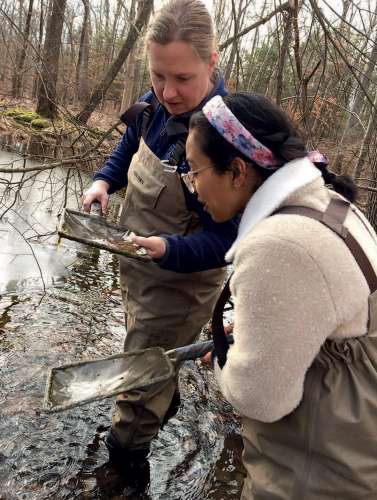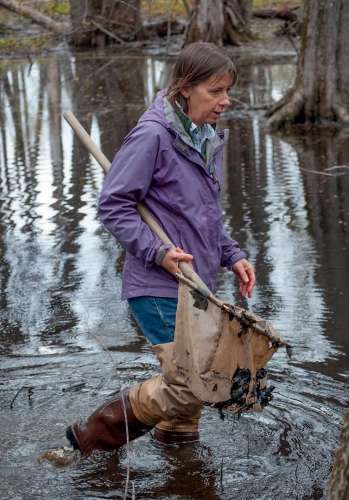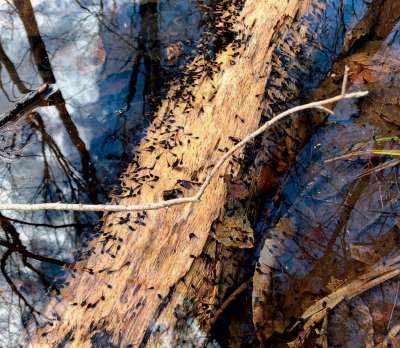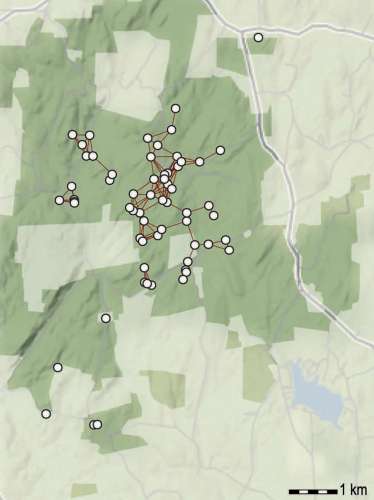
“If I was queen for a day, there wouldn’t be separation of terrestrial and wetland conservation,” said University of Maine’s Aram Calhoun, a dogged vernal pool advocate in classrooms and town halls alike. Her decades-long efforts contributed to the recent establishment of two pilot Special Area Management Plans (SAMPs) in Orono and Topsham. Under these plans, the Maine townships manage vernal pools not as isolated habitats but as connected units. The plans additionally emphasize the importance of protecting forests surrounding the pools, where amphibians spend most of their lives but – critically – SAMPs also integrate human needs into the landscape. This balancing of interests sets SAMPs apart from more exclusively habitat-focused models, such as Managed Units (MUs), which are a tough sell in communities focused on economic growth.
SAMPs have existed for some time at the federal level, and the U.S. Army Corps of Engineers often uses these plans to guide permitting decisions. “SAMPs are the Army Corps’ tool for managing tricky areas,” Calhoun explained. “A lot of marine environments fall under SAMPs. Vernal pools are tricky, too.” What makes the Topsham and Orono models distinctive from the Corps of Engineers’ SAMPs is that they were designed by the townships as a compromise between conservation and development goals. This provides a template for other towns that seek to conserve amphibian habitat while also allowing for new development.
The Orono and Topsham SAMPs depend on local implementation, monitoring, and enforcement. Each SAMP defines a development zone as well as protected areas. Developers can destroy or degrade pools and wooded habitats within the development zone, but when they do, they must pay fees to the township. The township uses this money to permanently protect other land in the SAMP’s development zone, or sometimes outside it, through easements and land trusts. (If funds are not used for land protection within a set amount of time, however, the township may use them for other purposes.) Although this approach is less than ideal for conservation, because it allows for the loss of individual pools, it ensures that pool networks in the protected areas of the SAMP remain.
To Calhoun, this is everything. “Amphibians are the knitters, threading wetland and terrestrial habitats together,” she said. “Vernal pools also provide abundant protein in and out of the pond through egg masses, juveniles, and adults. Everything from mink to owls to snakes to bears takes advantage, often in March and early April when food is scarce. Managing amphibians’ dispersal networks as units is the best way to keep them thriving, and SAMPs satisfy groups as diverse as biologists, contractors, land trustees, and economists. That’s not easy.”
Maine’s SAMPs, and more exclusively conservation-focused MUs, reflect the growing understanding among researchers and land managers that vernal pool obligates such as wood frogs and blue-spotted salamanders rely on interconnected pools, and that water and woods conservation can’t be teased apart.
Some of that research derives from the Yale School of the Environment’s Skelly Lab, where Freya Rowland, an aquatic ecologist now with USGS-Missouri, studied wood frog generations as metapopulations that encompass many pools rather than as isolated clans dedicated to single pools. “A metapopulation is an ensemble of populations connected by dispersal,” she explained. Working in 64 pools and drawing on Skelly Lab’s 21 years of egg mass data in northeastern Connecticut, Rowland documented the movement of newly metamorphosed wood frogs in her study area seeking out new breeding sites. Previous research has shown this dispersal rate is approximately 18 percent of a year’s population. This dispersal links pools that would otherwise host hermetic populations, thereby promoting genetic diversity across a metapopulation.
Rowland’s work suggests that a pool network buffers wood frog metapopulations both from localized threats to pools and also from region-wide climate conditions such as drought or warm winters. In both cases, a network protects the greater population from short-term losses in individual pools. For example, dragonfly nymphs might wipe out a typically highly productive pool’s tadpole generation one year, but the middling pond 300 yards east could simultaneously have banner numbers with some of those juveniles eventually migrating to the first pool. Three years later, disease might crush 75 percent of tadpoles network-wide, but at least some ponds will produce young frogs that, along with the older frog population, will help carry the metapopulation forward.
Likewise, the presence of pools in a network with favorable characteristics to remain productive despite climate stressors such as drought can compensate for more vulnerable pools.
“Pond depth and canopy cover were positively related to the number of egg masses we found in each pond,” Rowland noted. “Wood frogs have a three-month larval period, so shallower ponds are unfavorable. They also prefer cooler temperatures, so higher canopy cover is linked to more egg masses.” Deeper ponds, too, favor species with long larval periods, such as spotted salamanders, which require pools with extensive hydration periods.
Although Rowland’s research suggests that land managers should put a premium on protecting these highly productive pools, conservation of connected, less-productive pools is also important. These serve as a population backstop when the more productive pools fail. “Good and bad years don’t align across ponds,” Rowland explained. “That asynchrony provides a buffer against total recruitment failure during bad years, because as we’ve seen, a good pond isn’t always good.”




